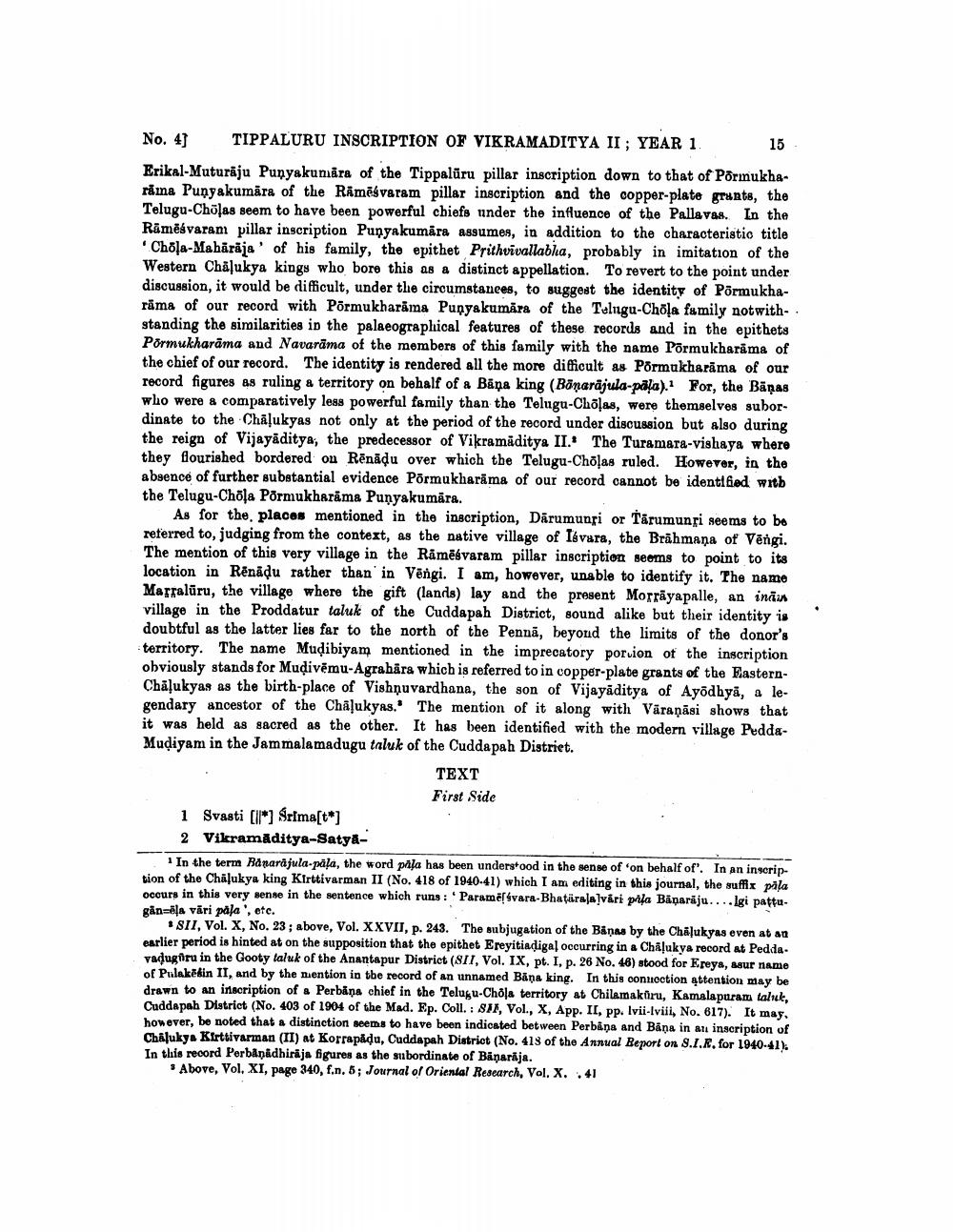________________
No. 4)
TIPPALURU INSCRIPTION OF VIKRAMADITYA II : YEAR 1
15
Erikal-Muturāju Punyakumara of the Tippalūru pillar inscription down to that of Põrmukharima Punyakumāra of the Râmēs varam pillar inscription and the copper-plate grunts, the Telugu-Cholas seem to have been powerful chiefs under the influence of the Palla vas. In the Rāmēšvaram pillar inscription Punyakumara assumes, in addition to the characteristic title
Chola-Mahārāja' of his family, the epithet Prithvivallabla, probably in imitation of the Western Chalukya kings who bore this as a distinct appellation. To revert to the point under discussion, it would be difficult, under the circumstances, to suggest the identity of Põrmukharäma of our record with Pörmukharama Punyakumāra of the Telugu-Chola family notwithstanding the similarities in the palaeographical features of these records and in the epithets Pormukharama and Navaräma of the members of this family with the name Pormukharama of the chief of our record. The identity is rendered all the more difficult as Pormukharāma of our record figures as ruling a territory on behalf of a Bāņa king (Bönarajula-pala). For, the Baņas who were a comparatively less powerful family than the Telugu-Cholas, were themselves subordinate to the Chalukyas not only at the period of the record under discussion but also during the reign of Vijayaditya, the predecessor of Vikramaditya II.' The Turamara-vishaya where they flourished bordered on Rēnādu over which the Telugu-Chõļas ruled. However, in the absence of further substantial evidence Põrmukharāma of our record cannot be identified witb the Telugu-Chola Põrmukharama Punyakumāra.
As for the places mentioned in the inscription, Dārumunfi or T'árumungi seems to be referred to, judging from the context, as the native village of Isvara, the Brāhmana of Vēngi. The mention of this very village in the Råmēsvaram pillar inscription seems to point to its location in Renādu rather than in Vëngi. I am, however, unable to identify it. The name Marralūru, the village where the gift (lands) lay and the present Morrāyapalle, an inaan village in the Proddatur taluk of the Cuddapah District, sound alike but their identity is doubtful as the latter lies far to the north of the Penna, beyond the limits of the donor's territory. The name Mudibiyam mentioned in the imprecatory porvion of the inscription obviously stands for Mudivēmu-Agrahara which is referred to in copper-plate grants of the EasternChalukyan as the birth-place of Vishnuvardhana, the son of Vijayaditya of Ayodhya, a legendary ancestor of the Châļukyas. The mention of it along with Varanasi shows that it was held as sacred as the other. It has been identified with the modern village PeddaMudiyam in the Jammalamadugu taluk of the Cuddapah Distriet.
TEXT
First Side 1 Svasti (il*Srima[t*]
2 Vikramaditya-Satya
1 In the term Banarajula pala, the word prila has been understood in the sense of 'on behalf of'. In an inscription of the Chalukya king Kirttivarman II (No. 418 of 1940-41) which I am editing in this journal, the suffix pila occurs in this very sense in the sentence which runs: 'Paramës svara-Bhatarala!vari pita Banarāju.... Igi pattugån=ēļa väri pala', etc.
*SI1, Vol. X, No. 23 ; above, Vol. XXVII, p. 243. The subjugation of the Baņas by the Chalukyas even at an earlier period in hinted at on the supposition that the epithet Ereyitiadigal occurring in a Chalukya record at Pedda. yadugiru in the Gooty taluk of the Anantapur District (8I1, Vol. IX, pt. I. p. 26 No. 46) stood for Ereya, asur name of Pulakekin II, and by the niention in the record of an unnamed Bana king. In this connection attention may be drawn to an inscription of Perbåna chief in the Telugu-Chola territory at Chilamaköru, Kamalapuram lalut, Cuddapah District (No. 403 of 1904 of the Mad. Ep. Coll. : SI1, Vol., X, App. II, pp. Ivii-Iviil, No. 617). It may, however, be noted that a distinction seems to have been indicated between Perbina and Bana in an inscription of Chalukya Kirttivarman (II) At Korrapadu, Cuddapah District (No. 41% of the Annual Report on S.I.R. for 1940-41), In this record Perbånadhiraja figures as the subordinate of Banarija.
. Above, Vol. XI, page 340, f.n. 5; Journal of Oriental Research, Vol. X. . 41




